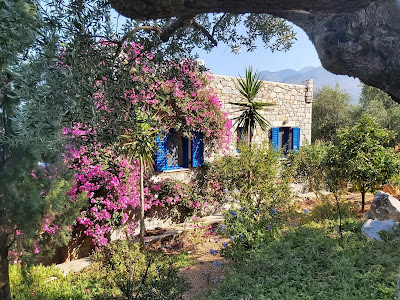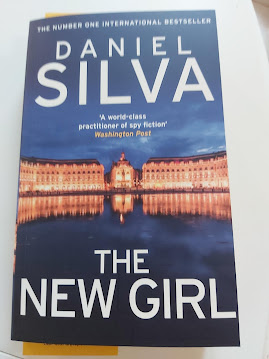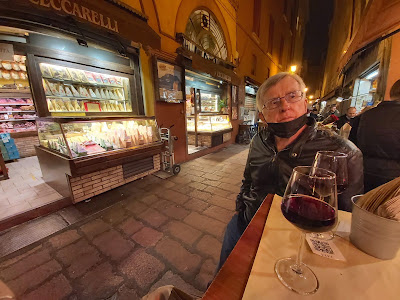The jackhammer's pounding on the floor above us rattled the ceiling, the walls and our brains. From the furthest points in the upper garden to the lowest level of the olive grove, there was no getting away from it.
 |
| The Stone House on the Hill |
For two and a half days, the racket of those mechanical waves dislodging and destroying the massive centerpiece our living room, shattered the silence of this rural slice of Greece. It nearly shattered our resolve for the project as well, as we cringed, encamped in the guest room on the lower floor.
So painfully obnoxious was the sound, that our next-door neighbor said he'd been ready to start wearing his noise cancelling headphones inside his home.
 |
| The Stone House on the Hill |
While I had once chuckled at the hilarious tales of stone house renovations recounted by writers Peter Mayle in France and Frances Mayes in Italy, I found nothing humorous about it now that we were experiencing it first hand at our Stone House on the Hill in the Greek Peloponnese.
If the sound didn't do us in, I was certain we'd be asphyxiated by the concrete and stone dust that filled the house.
And had we succumbed to one or the other, we'd have had no one else to blame but ourselves. . . we had chosen this path of destruction and there was no turning back.
Time for a Change
 |
| The Stone House on the Hill built in terraced olive grove |
Early this year, we had declared it the Year of Change at our spitiki, small house, in Kalamata olive growing country. The layout of our Stone House on the Hill follows that of our olive grove which marches down the hillside on steep terraces. Thus the three floors of our home are built on terraces that were long ago carved into the hillside to accommodate olive trees. Stairs lead to the house and stairs connect the floors of the house.
 |
| The early years look at The Stone House on the Hill |
Our 15-year-old house (still an infant when viewed in the overall span of Greek history) felt and looked tired when we bought it. In the seven years we've owned it, there have been small cosmetic changes, but this year would herald a major makeover. It was definitely time for a face lift and body sculpting!
New closets were installed in July which provide more storage space, yet take up less floor space than the originals that came with the house.
 |
| Our new front door |
That same month we gave the house its first facelift by replacing the original muted green windows and doors with energy efficient ones - their vibrant blue giving new life to the interior and exterior of the home.
 |
| Tile replaced flagstone on the front deek |
With October's summer-like weather the third of four projects was completed. It was another facelift, the installation of tiles on our outdoor deck to create more of an outdoor room than flag-stone paved patio. And it worked! The project brightens the deck and gives the feel of having increased the space.
 |
| Tiled Outdoor room/deck at The Stone House on the Hill |
Buoyed by the outcomes of those projects, we moved to the grand finale, or what will now forever be remembered as 'the mother of all projects' here. We were finally getting rid of the massive stone stairway that looked as if it belonged in the lobby of some grand hotel and not the small living room in our house.
Dreams Undeterred
 |
| The original stone stairs in The Stone House |
Throughout the spring and summer I would imagine a house without that massive stairway. Okay, so maybe I was obsessing about it, but I'd grab my tape measure, or metro, and I would measure the structure and announced to The Scout that we would create 'x-amount' of living space if we were just to get rid of 'those' stairs. In fact I announced it to every visitor who walked through the front door and to any poor soul who would listen to me.
The Scout, using that voice-of-reason tone that husband's often use, pointed out how miserable the project would likely be as we'd need to remove its stone and concrete base, read that: dirt and dust. Then we'd likely find more stone and concrete inside. (He was right, btw.)
His even more spot-on reality check was that we had no idea how to go about coordinating such a project and certainly didn't know of any stair contractors.
 |
| The truck said 'stairs' - we were on our way! |
Fate was with us (as it so often is in this expat life) as one morning we literally drove past the van of a stair building company working on a house in the village. One Greek word I know is skala, or stairs, and it appeared on the side of the van. By afternoon the contractor was at our house. We shook hands on his proposal and the project was underway!
Paniotis, the 'stair master' as we named him, returned a few days later with the men who would destroy and rebuild the living area. He set out the plan of action: demolition, rebuild of the wall and re-tile the space exposed by the stair removal. Like dominoes falling, those steps would be completed and then he could install a much more compact open wooden stairway.
Two weeks was the estimate from start to finish.
Out with the Old, In With the New
 |
| Provlima: wires ran through the stairs |
The demolition was barely into its second hour when the workers called out, 'Ella! . . .Provlima!' (Come! Problem!). Removing the wooden treads had revealed not only more concrete under the stairs but a major bank of electrical wires that ran their full length from the wall to the floor.
 |
| Provlima solved - meeting of the minds |
The team - stair builder, demolition duo, the tiler and the recently-added electrician - gathered at the stairway that afternoon in a hastily called meeting. We took our places as spectators. They scratched chins and heads, pointed and measured. Voices sometimes raised, as is the case of most Greek conversations, options were discussed.
After a time, Paniotis turned to us and said, 'Yes, we can do this.' He drew a plan of action sketch, all viewed it, and it was taped to the refrigerator door as a handy reference.
 |
| The plan on the back of an envelope |
The meeting adjourned and the jackhammer resumed its destructive percussion.
 |
| Jackhammer serenade resumed |
What seemed an eternity later, the jackhammers were silenced, the space cleared and, our master stone mason began putting the wall back together, creating a niche for adornment and then floor tiling was completed. We marveled at his skill in putting the house back together.
 |
| Stone mason magic |
Much of the stair work had been done in the Kalamata workshop so installation required one very long work day.
 |
| The new stairs |
Day 12 found us up to our elbows cleaning concrete dust that had escaped despite the best attempts at sealing off the workspace. Cleaning finished, furniture moved back into place and by Day 14 we were settled into our new Stone House on the Hill -- one that now has an enormous amount of space in the living area.
 |
| Footprint of the old stairway |
Time to Travel
We are now back to doing what we do best: planning and packing for travel. As Covid continues to dictate protocols and preparation for travel, countries on this side of the pond are open and welcoming travelers.
 |
| Protocols and preparations begin for travel |
Way back when we bought our stone house it was to serve as a launchpad for adventures. It is time we start using it as just that! We are off next week. . .and I'll tell you about it in upcoming posts. Until then wishes for continued health and happy travels to you and yours. Hope you'll be back and bring a friend or two with you! And as always, thanks for your time today.
Linking soon with:



































